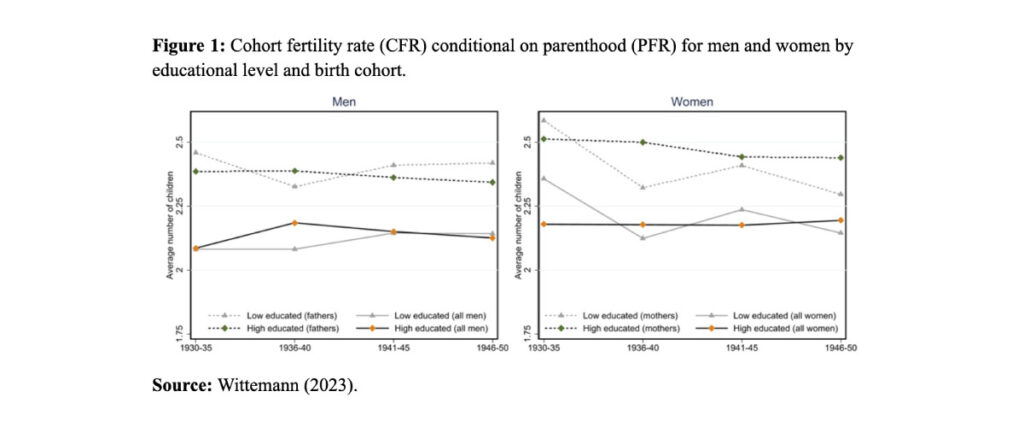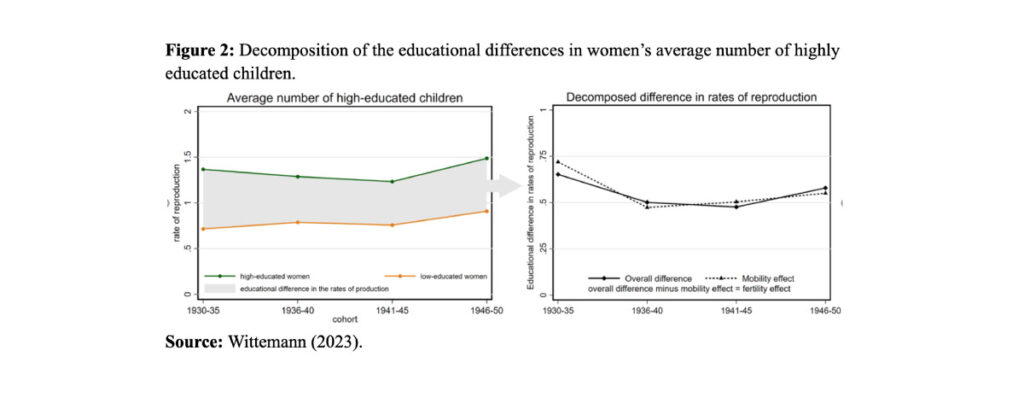All over the world, children’s education mirrors that of their parents. This, together with differential fertility, affects the distribution of educational outcomes in the next generation. In Sweden, however, differential fertility is negligible: as Vanessa Wittemann shows, what really matters is the ability of highly educated parents to transmit their advantage to their descendants.
Education and fertility
Highly educated people are likely to transmit their educational level to their children, leading to unequal educational chances between children with high- and low-educated parents (Hällsten and Pfeffer 2017). This is a concern in Western societies where ideals of equal opportunity are widespread.
In a simplified representation of reality, the educational distribution of any birth cohort can be modelled as a function of two variables: the “transmission of (dis)advantage” from parents to children and differential fertility between high- and low educated parents. And it is known that in most European countries highly educated people tend to have fewer children, and to remain childless more often (Van Bavel et al. 2018).
In a recent paper, I investigated the processes that shape the formation of the educational distribution in the generation descending from people born between 1930 and 1950 in Sweden, considering not only social factors but also how demographic factors contribute to the formation of a specific educational distribution (Wittemann 2023).
Data and difficulties
Studies of this type are rare because they are very demanding in terms of data and time. Ideally one would need to follow a generation in a long panel of observations until
• they have finished their education,
• some of them have had children, and
• their children have finished their education.
However, problems are huge: such data are rare, very hard to collect even where they exist, dropouts are common, etc. For my study, I used usual survey data, namely the Generations and Gender Survey, which has information about educational attainment, number of siblings, year of birth, parents’ year of birth, and parents’ educational attainment. For all groups, I categorized as highly educated those with a post-secondary educational level (ISCED levels 4-6).
With this information, I was able to reconstruct the parental generation born between 1930 and 1950 in Sweden. Unfortunately, some crucial information about this generation is missing, i.e. about those who did not have children. If these people are not random (for example, more often highly educated), they also indirectly contribute to the educational distribution of the following generation.
To account for this possible source of bias, I calculated the probability of remaining childless conditional on educational attainment using several other data sources: the European Social Survey (ESS), the Survey of Health, Ageing, and Retirement in Europe (SHARE) and, again, the Generations and Gender Survey (GGS). In short, I applied to the Swedish case the method developed by Skopek and Leopold (2020).
Trends in fertility
I found that the fertility of the Swedish cohorts born 1930-1950 is not clearly educationally stratified, either for men or for women. The average number of children ranges between 2.08 and 2.18 for men and between 2.12 and 2.36 for women, accounting for childlessness. Considering only parents, the average number of children clusters around 2.40 for men and 2.45 for women. In short, as shown in Figure 1, there is only a small fertility difference between high- and low-educated individuals in Sweden. This differs from what Skopek and Leopold (2020) found for Germany, and especially West Germany, where high-educated women had markedly higher levels of childlessness.

The overall picture: social and demographic pathways of reproduction
The left side of Figure 2 shows the educational difference of women in the so called “rate of reproduction”. This is simply the average number of highly educated children a high- or low-educated mother is expected to have, which I calculated accounting also for childlessness. On average, and not surprisingly, highly educated women have more highly educated children than low-educated women. This illustrates that also in an egalitarian country like Sweden, a person’s education is strongly connected to that of his or her parents. However, in Germany this is even more pronounced (Skopek and Leopold 2020).
The right side of Figure 2 decomposes this difference into a mobility effect and a fertility effect. The term mobility effect here refers to social and unexplained mechanisms that are usually connected to unequal opportunities of education. The fertility effect indicates how much of the difference is due to differential fertility. As the fertility patterns have already suggested, educational transmission in Sweden is mainly driven by the mobility component.

Note that in Sweden I found no connection between family size and the probability of attaining high education. In Germany, by contrast, each additional child in a family reduces every child’s chances of attaining higher education (Skopek and Leopold 2020). That this does not hold in Sweden may be connected to a comprehensive welfare state with massive social policies and a less stratified educational system. Family policies in Sweden further facilitate combining female employment and childrearing, which explains, at least in part, the high fertility of high-educated women and, at the same time, a relatively high female labour force participation.
This, I believe, is why no pattern of a negative fertility gradient emerges in Sweden.
References
Hällsten, M., & Pfeffer, F. T. (2017). Grand Advantage: Family Wealth and Grandchildren’s Educational Achievement in Sweden. American Sociological Review, 82(2), 328–360. https://doi.org/10.1177/0003122417695791
Skopek, J., & Leopold, T. (2020). Educational Reproduction in Germany: A Prospective Study Based on Retrospective Data. Demography, 57(4), 1241–1270. https://doi.org/10.1007/s13524-020-00896-2
Van Bavel, J., Klesment, M., Beaujouan, E., Brzozowska, Z., Puur, A., Reher, D., et al. (2018). Seeding the gender revolution: Women’s education and cohort fertility among the baby boom generations. Population Studies, 72(3), 283–304. https://doi.org/10.1080/00324728.2018.1498223
Wittemann, V. (2023). Educational reproduction in Sweden: A replication of Skopek and Leopold 2020 using Swedish data. Demographic Research, 48(25), 733–774. https://doi.org/10.4054/DemRes.2023.48.25


